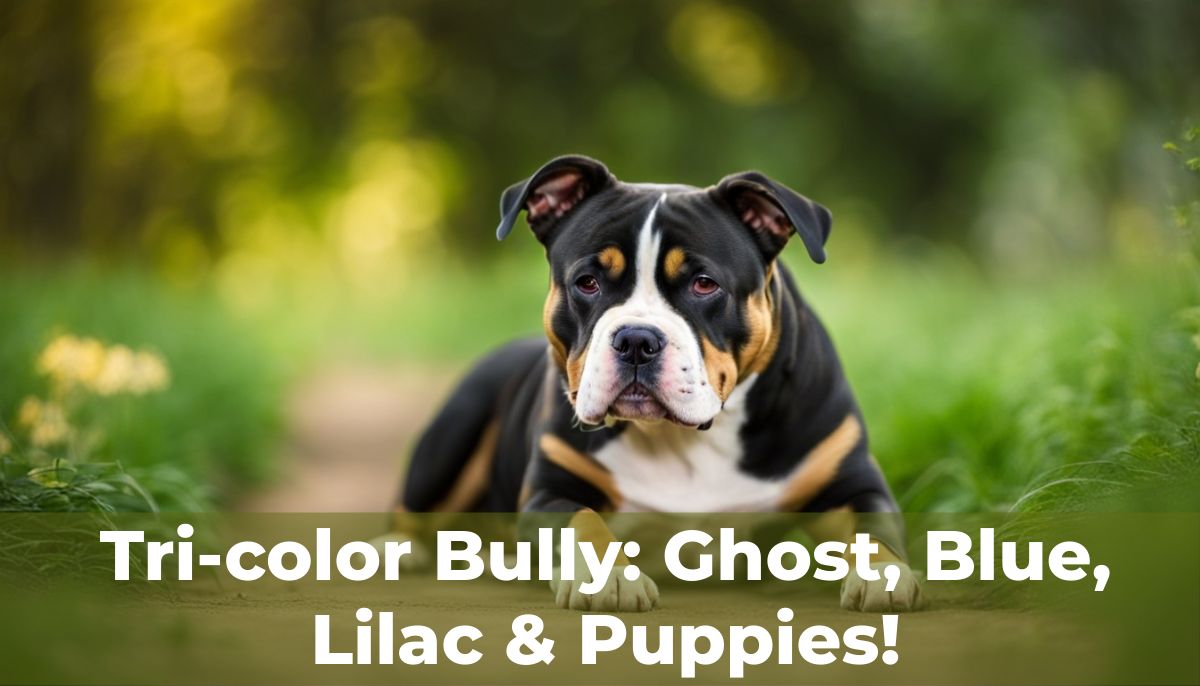Have you ever heard of a dog breed called the Tri-Color Bully? Well, if you’re a dog lover or thinking about getting a new furry friend, you’re in for a treat! This unique and charming breed has been gaining popularity for its distinctive and eye-catching coat patterns.
Well, for one thing, I’m a huge fan of the breed. I love their striking coats and their gentle temperament. I’ve also done a lot of research on the breed, including talking to breeders and owners.
In this article, we’ll delve into the world of Tri-Color Bullies, exploring their origins, characteristics, and what makes them such wonderful companions.
So, grab a cup of coffee and get ready to learn all about this fascinating breed that’s capturing hearts across the globe.
What Is the Tri-Color Bully?
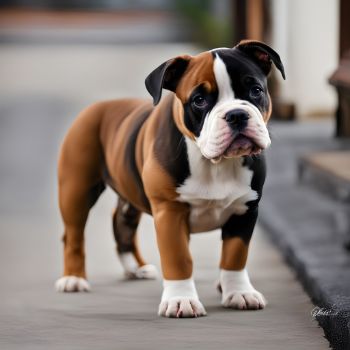
The Tri-Color Bully is a cross between the American Bulldog and other breeds, such as the American Pit Bull Terrier, English Bulldog, and French Bulldog.
Now, the “tri” in its name stands for three, like a triangle has three sides.
It means these dogs have not one, not two, but three colors in their coat.
Imagine a dog with a coat that looks like an artist’s palette, with a mix of three beautiful colors.
It’s a bit like having a furry canvas of browns, blacks, and whites on your dog.
Is it a separate breed?
No, the Tri-Color Bully is not a separate breed. It’s actually a unique variation of the American Bully breed. Think of it like different flavors of ice cream – they’re all part of the same ice cream family, but each flavor has its unique twist.
In this case, the Tri-Color Bully has a distinct coat color pattern that differentiates it from other American Bullies.
History of Tri-Color Bully:

The journey of the Tri-Color Bully began in the United States during the 1990s.
The Tri-Color Bully is a fascinating breed that has a captivating history.
The breed was developed by crossing American Bulldogs with other breeds, such as Pitbull Terriers, American Staffordshire Terriers, and English Bulldogs.
The goal was to create a dog with a muscular build, a gentle temperament, and a striking tricolor coat.
The first Tri Color Bully was registered in 2004, and the breed quickly gained popularity.
Today, Tri-Color Bullies are one of the most popular breeds of American Bulldog.
Tri-color Bully bloodlines:
Tri-color bully dogs have different family trees or bloodlines. Think of it like tracing your family history but for dogs. These bloodlines are like the family stories of our furry friends.
These are like famous last names in the world of Tri-Color Bully dogs. These bloodlines are like the roots of the Tri-Color Bully family tree. They define the looks, temperament, and traits of these dogs.
It’s like how in a human family, some people are tall, some are great athletes, and others are kind and caring.
Here are some of the most popular Tri Color Bully bloodlines:
- Razor’s Edge: Known for their broad heads.
- Gotti: Famous for a stocky build.
- Daxline: Loved for their broad chests.
- Miagi: Often praised for a compact size.
- Kingpin: Known for their strength.
- TriLine: Adds distinct traits to the mix.
- Venomline: Known for their muscular appearance.
- BullyPro: Brings a unique blend of qualities to the breed.
Tri-color bully genetics:
They have a primary or base color that forms the background of their coat. This base color could be black, blue, or chocolate.
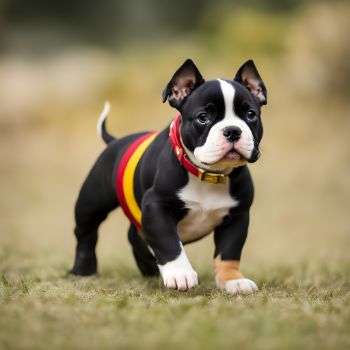
First, we have the base color. It is the primary color that covers most of the dog’s body. Tri-Color Bullies often have a base color like black, blue, or chocolate.
The “a” gene determines the base color, whether it’s black (AA), blue (aay), chocolate (aaw), or lilac (aadd).
Next, we have white markings. These are the spots of white you see on their body. They can be on the chest, paws, or face. These white markings come from specific genes that tell the dog where to have these spots. There’s the “S” gene for white markings.
Now, let’s talk about the role of Tan Points. They usually appear on the eyebrows, cheeks, paws, and under the tail. These tan points are controlled by different genes that interact with the base color. The “T” gene controls the presence of Tan Points.
Why are tri-color bullies so popular?
Tri-color bullies are the perfect combination of beauty, brains, and brawn.
Tri-Color Bully Pits have become famous for several good reasons.
- First off, their striking coat patterns make them stand out in a crowd. Those patches of color, combined with their muscular build, catch people’s attention and make them unique.
- Tri-Color Bully Pits are known for their friendly and gentle nature. People love dogs that are not only good-looking but also great companions. These dogs are often very loyal and make fantastic family pets, which is a big plus.
- Tri-color bullies are also popular among certain specific groups of people. For example, tri-bullies are popular among people interested in dog shows and competitions.
- Their manageable size is another factor. They’re small, making them well-suited for apartments and larger homes. It makes them a practical choice for many families.
Is it any wonder that tri-pit bullies are so popular?
The Tri-Color Pattern:
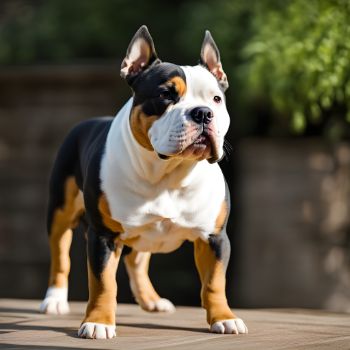
The beauty of the tri-color pattern is its uniqueness and variability. No two tri-color bullies are exactly alike.
The distribution of the black, white, and tan pigments can vary greatly from dog to dog. It creates a wide range of different coat markings, each with unique beauty.
Another thing that makes the tri-color pattern so beautiful is its contrast.
The three colors often complement each other, creating a visually stunning effect.
For example, the black and tan colors can create a striking contrast, while the black and white colors can create a more elegant look.
What Causes the Tricolor Coat Pattern?
The captivating Tricolor Coat Pattern in American Bullies is the result of intricate genetic combinations. Think of it as an artist’s palette, with each gene playing a crucial role in shaping the dog’s coat.
Two primary genes stand at the core of this genetic masterpiece: the “B” gene and the “S” gene.
- The “B” gene determines the base color, black, blue, chocolate, or lilac, acting as the canvas upon which the coat pattern is painted.
- Meanwhile, the “S” gene plays an artist’s brush, creating white markings. These white patches appear on the chest, face, legs, and other areas, enhancing the overall beauty of the coat.
Yet, there’s more to the story.
- Enter the “T” gene, responsible for Tan Points, which adds the finishing touches like an artist’s signature. With rich tan or reddish colors, these areas grace the eyebrows, cheeks, legs, and under the tail.
The genetic factors don’t end here.
- The agouti gene is a crucial player in distributing black and tan pigments within the coat. It ensures that the black pigment is concentrated in specific areas, resembling a saddle and mask.
In contrast, tan pigment shines on the legs, chest, and face.
Tan point gene Origin in Tri Bullies:
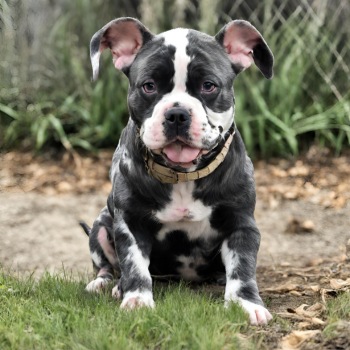
The Tan Point gene, often denoted as the “T” gene, is inherited by American Bullies through generations of breeding.
Breeders selectively choose dogs with the desired traits, including the presence of Tan Points, and ensure they pass on these traits to their offspring.
The “T” gene, responsible for the distribution of tan or reddish color in the eyebrows, cheeks, legs, and under the tail, is a result of naturally occurring genetic variation.
It’s not something that was added or introduced; instead, it’s part of the genetic diversity in dog populations.
Origin of tricolor gene in American Bully:
The tricolor gene in the American Bully came from the American Staffordshire Terrier (AmStaff) and the Pitbull Terrier. Both of these breeds are known for having tricolor coats.
The tricolor gene is a recessive gene, meaning that both parents must carry the gene in order for the puppies to have the tricolor coat.
The American Bully breed was developed by crossing the AmStaff with the Pitbull Terrier, so it is not surprising that the American Bully also has the tricolor gene. The tricolor gene is famous among American Bully breeders, producing puppies with unique and striking coat markings.
Is a Tri-Color Bully a Pitbull?
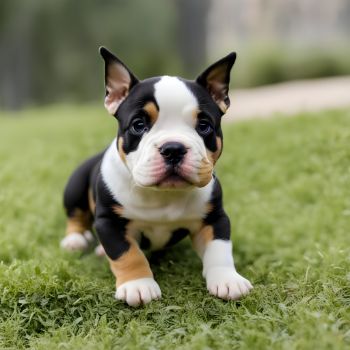
The American Kennel Club (AKC) which is like the official “referee” in the world of dog breeds, recognizes several breeds as Pitbulls, including these:
- American Pit Bull Terrier
- American Staffordshire Terrier
- Staffordshire Bull Terrier
- American Bully
So yes, the connection between Tri-Color Bullies and Pitbulls is there, and it’s more intricate than you might think.
Tri-Color Bullies are a crossbreed between the American Pit Bull Terrier and the American Staffordshire Terrier.
Types of tri-color bullies by size
Tri color bullies are American bullies with three colors in their coats. The two most common colors are tan and white, with the base color varying.
Tri color bullies come in a variety of sizes and can be classified into the following categories:
1. Standard Tri American Bully
Standard American bullies are the most common type of bully and range in height from 17 to 20 inches at the shoulder.
They have a muscular build and a stocky frame.
Tri color standard bullies are known for their gentle and loving temperament.
Standard American bullies are a great choice for families with children, as they are typically very patient and tolerant.
2. Classic Tri color Bully
The “Classic” Tri-Color Bully is a bit smaller than the Standard but still has that classic bully look.
They usually stand around 16 to 19 inches at the shoulder and weigh between 60 to 100 pounds.
Classic tri color bullies make great companions for active people, as they enjoy plenty of exercise.
3. Pocket Tri Bully
If you’re looking for a more compact buddy, the “Pocket” Tri-Color Bully is the one. These little guys stand around 13 to 16 inches at the shoulder and weigh between 10 to 25 pounds.
Pocket tri color bullies are a good choice for people who live in apartments or small homes, as they only require a little space. They are also relatively low-maintenance, making them a good choice for busy people.
4. Tricolor Exotic Bully
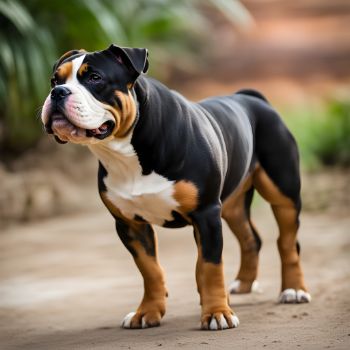
Exotic bullies are a newer type of bully bred for a more extreme appearance.
They have a shorter muzzle, a wider head, and a more muscular build than other bullies.
Tri color exotic bullies are rare and can be pretty expensive. They’re like the trendsetters of the bully world.
There are better choices than exotic tri color bullies for first-time dog owners, as they can be more challenging to train.
They are also not a good choice for families with young children, as they can be more aggressive than other bullies.
5. Tricolor Micro Bully
If you’re all about the “micro” life, these are the smallest Tri-Color Bullies. They stand as short as 10 to 13 inches at the shoulder and weigh between 30 to 50 pounds. These little guys are full of personality, packed into a tiny package.
Micro tri-color bullies are not recommended for families with young children, as they can be easily injured. They are also not a good choice for people who live in cold climates, as they are more susceptible to the cold.
6. Tri Color American Bully xl
XL American bullies are the largest type of bully and range in height from 21 to 23 inches at the shoulder. They have a very muscular build and a powerful presence. Tri color bully xl are gentle giants and make quite the impression.
Compaison Table
| Characteristic | XL Bully | Standard Bully | Classic Bully | Micro Bully | Exotic Bully | Pocket Bully |
|---|---|---|---|---|---|---|
| Size | Very large | Large | Large | Small to medium | Compact | Small |
| Weight | 90-170 pounds | 70-120 pounds | 60-100 pounds | 30-50 pounds | 50-70 pounds | 10-25 pounds |
| Coat Color | Tricolor or other | Various colors | Various colors | Various colors | Various colors | Various colors |
| Exercise Needs | Moderate to high | Moderate | Moderate | Moderate | Moderate | Moderate |
Are Tricolor Bullies different from other Bullies?
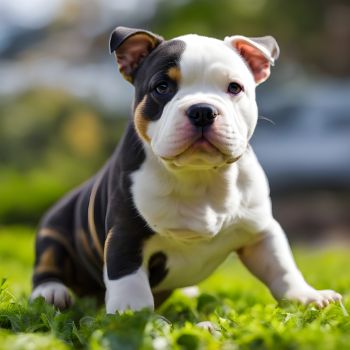
Tri-Color Bullies are distinct when it comes to their coat markings. As the name suggests, they have a tri-color pattern, meaning their fur combines three different colors. In contrast, other Bullies may have single or dual-color coats.
When it comes to weight and height, Tri-Color Bullies vary depending on their specific type. Standard Tri-Color Bullies tend to be larger, while Pocket and Micro Tri-Color Bullies are notably smaller. Other Bully breeds may also come in different sizes.
Tri-Color Bullies are known for their friendly and outgoing temperament. They are often great family pets, displaying loyalty, intelligence, and affection.
Other Bullies, like the American Pit Bull Terrier and American Staffordshire Terrier, share these positive characteristics. Still, individual temperament can vary depending on different factors.
Tri color bully lifespan:
Like other American Bully variations, the lifespan of a Tri-Color Bully typically ranges from 8 to 13 years. Of course, individual dogs can vary, but with proper care and a good lifestyle, many Tri-Color Bullies live comfortably into their teens.
So, if you’re thinking about bringing one of these colorful canines into your life, you can look forward to many years of companionship and joy.
Temperament and Behavior:
Tri-Color Bullies are known for their warm and friendly temperament. They’re like that loyal friend who’s always excited to see you.
Affectionate: These pups are big lovers. They enjoy being close to their human family and often seek cuddles and attention. You can count on a Tri-Color Bully to brighten your day with their affection.
Loyal: Loyalty is their middle name. Once they bond with their family, they’re there through thick and thin. They make excellent companions who stand by your side.
Intelligent: Tri-Color Bullies are smart cookies. They learn commands quickly and love new tricks. Mental stimulation is just as essential to them as physical exercise.
Playful: They’ve got a playful spirit. Tri-Color Bullies love a good game of fetch or a romp in the park. Playtime is a must to keep their spirits high.
Sociable: These dogs are social butterflies. They tend to get along well with other dogs and often enjoy the company of people. They’re not the introverted types.
Protective: Tri-Color Bullies have a protective streak. They’ll look out for their family and home, making them a reliable choice as a watchdog.
Shedding & Grooming:
Tricolor Bullies have a short, smooth coat that requires minimal grooming. They typically shed seasonally, in the spring and fall. However, they may shed lightly throughout the year.
Grooming: Grooming is straightforward. Regular brushing with a soft brush helps remove loose hair and keeps its coat looking shiny. You won’t need to spend hours at the groomer’s. Tri-Color Bullies have a natural, easy-care beauty.
Use a de-shedding tool on your dog to remove loose hair. There are a variety of de-shedding tools available, so choose one that is appropriate for your dog’s coat type.
Bathing: Occasional baths are enough when they get dirty or smelly. Just be sure to use a mild dog shampoo, and they’ll be fresh and clean.
Nails and Ears: Don’t forget to trim their nails as needed and check their ears for any dirt or wax buildup.
Caring for a tri-colored American bully:
Taking care of these lovely dogs is like looking after a good friend.
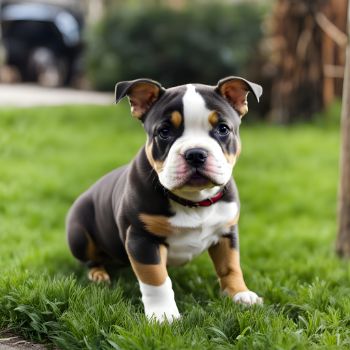
1. Balanced Diet: Start with good food. Make sure to feed them a well-balanced diet appropriate for their age and size. Quality dog food with essential nutrients is the key to their well-being.
2. Regular Exercise: Keep them active. Tri-Color Bullies love to play and need regular exercise to stay fit and happy. Daily walks, playtime, and mental challenges like puzzle toys are perfect.
3. Vet Visits: Regular check-ups with the vet are essential. It helps catch any health issues early and keeps them up to date on vaccinations and preventive care.
4. Socialization: Tri-Color Bullies are social dogs. Expose them to different people, places, and other dogs from a young age. It helps them become well-adjusted and friendly.
5. Love and Attention: Remember the love. These dogs thrive on affection and companionship.
Spend time with them, play, and offer positive reinforcement during training.
6. Safe Environment: Ensure a safe living environment. Dog-proof your home, secure your yard, and keep harmful substances out of reach.
Do Tan point genes cause health problems?
When it comes to dogs with tan point genes, like Tri-Color Bullies, there are a few concerns to keep in mind. The tan point genes can sometimes be linked to specific issues:
Skin Sensitivity: Dogs with tan point genes may have more sensitive skin in the tan-colored areas. It’s essential to protect these areas from excessive sun exposure to avoid sunburn.
Allergies: Some dogs with tan point genes might be prone to skin allergies. It’s essential to keep an eye on their skin and address any signs of irritation.
Eye Conditions: In a few cases, dogs with tan point genes may be more susceptible to certain eye conditions. Regular eye check-ups are a good practice to ensure their eye wellness.
American Bully Health Survey (2021):
This study surveyed over 10,000 American Bully owners to collect data on the health and temperament of the breed. The study found that American Bullies are generally healthy dogs.
Still, they are prone to some health conditions, such as hip dysplasia, elbow dysplasia, and allergies. The study also found that American Bullies are typically friendly and outgoing dogs.
Housebreaking and crate training tips
Here are some housebreaking and crate training tips for a tri-bully:
Housebreaking Tips:
Consistent Schedule: Like clockwork, take your pup outside after waking up, eating, and playing. Tell them “good job” for going potty outside.
Designated Spot: Choose a specific spot in your yard for potty breaks. Dogs like routine and will understand where to go.
Praise and reward: When your puppy goes potty outside, praise them lavishly and give them a treat. It will help them learn that going potty outside is a good thing.
Use a potty cue. Say a word or phrase such as “go potty” before you take your puppy outside. It will help them associate that phrase with going to the bathroom.
Expert Advice:
Clean up accidents immediately and thoroughly. Dogs are attracted to the smell of their own urine, so it is important to clean up accidents as soon as possible. Use an enzymatic cleaner to remove the odor altogether.
Crate Training Tips:
Choose the right crate:The crate should be big enough for your tri bully to stand up, turn around, and lie comfortably.
Introduction: Make the crate inviting with a comfy bed and some toys. Allow your puppy to explore the crate at their leisure.
Not a Punishment: Always use the crate as a safe and comfortable space, not as a form of punishment.
Are Tri-Color Bullies Rare?
Tri-Color Bullies are rare, but they’re not like finding a hidden treasure either. Their three-color coat makes them less common among Bullies, but you can find them if you look in the right places. It’s like spotting something special, not something you see every day, but it’s out there for those who want it.
The rarity of tri color American bullies is that the genes for the tan point and black coat colors are recessive. It means that both parents of a tri-colored American bully must carry the genes for both coat colors for the puppy to be tri-colored.
Are Tri Color Bullies Hypoallergenic?
Tri-color American Bullies are not hypoallergenic. They are a heavy-shedding breed, which means they shed much fur, especially during the spring and fall.
They also have a double coat, which means they have a thick undercoat of skin that helps to keep them warm in the winter and cool in the summer. However, this also means that they shed more hair than other breeds of dogs.
Tri color bully puppy:
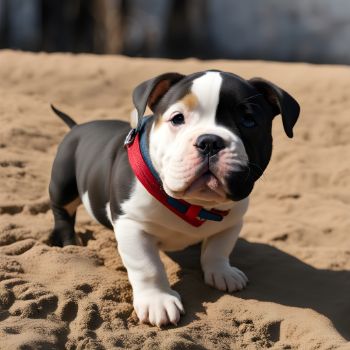
The offspring of Tricolor American Bullies are like little bundles of joy. They’re tiny, adorable, and full of energy.
Tri-color bully puppies have those striking three colors in their fur, which makes them even more charming.
Their coat patterns can mix white, black, brown, or other shades.
These puppies are all about playtime. They’re curious and love exploring their surroundings. Toys become their best buddies.
While they’re smart, they’re also a bit naughty. Early training is vital to help them grow into well-behaved adults. They can pick up commands quickly with the right guidance.
They’re great for families, especially if you have kids. They’re often patient and gentle with children.
Can Non-Tricolored Bullies Produce Tricolored Puppies?
Yes, non-tricolored bullies can produce tricolored puppies because the gene for the tricolored coat pattern is recessive. Both parents must carry the gene for the puppy to be tricolored.
Even if a parent does not have a tricolored coat, they can still carry the gene and pass it on to their offspring.
Fact:
A tricolored coat pattern is not the only factor that determines a dog’s coat color. Dog’s breed and other genes can also play a role.
For example, let’s say we have two non-tricolored bullies, one with a black coat and one with a brown coat. If both parents carry the gene for the tricolored coat pattern, there is a 25% chance that each puppy in the litter will be tricolored.
Here is an example of a cross between two non-tricolored bullies that could produce tricolored puppies:
- Father: Black bully
- Mother: Brown bully
Possible offspring:
- Black bully
- Brown bully
- Tricolored bully
Do all American Bully variations produce Tri-Color Bullies?
No, Tri-Color Bullies are not found in all American Bully variations. The tri-color coat pattern is specific to certain American Bully types. For instance, it’s more commonly seen in the Standard and Pocket variations but less often in the Classic, Micro, or Exotic Bully types.
Think of it like flavors of ice cream – you have different variations, and not all of them come in every flavor. Each American Bully variation has unique characteristics, and the tri-color coat pattern is more prominent in some than others.
So, if your heart is set on a Tri-Color Bully, you’ll want to focus on the Standard and Pocket types to find the coat pattern you’re looking for.
Myths surrounding the Tri-Color bully:
The Tri-Color Bully is a beautiful and unique dog, but there are many myths surrounding the breed.
Aggressiveness
Some people think that Tri-Color Bullies are naturally aggressive. Tri-Color Bullies are no more aggressive than any other breed of dog. Temperament is primarily determined by genetics and training, not coat color.
All Tri-Colors Look the Same
Not all Tri-Color patterns are identical. They can have different combinations of white, black, brown, or other colors, making each one unique.
Tri-Colored Bully vs. Other Breeds
| Characteristic | Tri-Colored Bullies | Other Breeds |
|---|---|---|
| Appearance | Tricolor coat, muscular build, stocky frame. | Varies widely in color, body type, and head shape. |
| Temperament | Friendly, loyal, protective. | Varies by breed (calm, energetic, protective, etc.). |
| Size | Medium to large, males larger. | Varies by breed (small, medium, large). |
Pros and Cons:
Pros:
- Their striking coat patterns set them apart.
- They’re known for their intense loyalty to their families.
- They bring lots of fun and energy to your home.
- They adapt well to different living environments.
Cons:
- Their intelligence can lead to stubbornness.
- They require regular physical activity.
- They may trigger allergies in sensitive individuals.
- They can be prone to breed-specific health issues.
Factors Influencing the Tri color Bully price:
1. Bloodline Pedigree: A strong family tree can raise the price.
2. Coat Pattern Rarity: Unique patterns can make them pricier.
3. Breeder Reputation: Trusted breeders may charge more.
4. Age and Training: Younger pups often cost less.
5. Health Screening: Health-checked dogs may be more expensive.
6. Demand and Location: Prices can vary by region and popularity.
Tri color American bully Cost:
Here is a price range of different Tri-Bully variations based on current market trends:
| Standard Tri Bully | $1,000 – $2,000 |
| Pocket Tri Bully | $1,500 – $3,000 |
| Classic Tri Bully | $2,000 – $3,500 |
| Micro Tri Bully | $2,500 – $4,000 |
| Exotic Tri Bully | $3,000 – $5,000 |
| XL Tri Bully | $3,000 – $5,500 |
Why some variants are more expensive than others?
Rare variation: Some Tri-Color Bully variants are rarer than others. For example, Micro Tri-Color Bullies are rarer than Standard Tri-Color Bullies. It’s because it is more challenging to breed Micro Tri-Color Bullies.
Demand: The demand for a particular Tri-Color Bully variant can also affect its price. For example, the high demand for pocket bully can raise its cost.
Rarity of Coat Pattern: Variants with rarer or more intricate coat patterns tend to be pricier. These unique patterns are often in high demand.
Buy and Adoption:
If you are wondering Where to find tri-color bully, then there are two main ways to get it: buying one from a breeder or adopting one from a rescue or shelter.
Buying
You can find Tri-Color Bully puppies for sale from reputable breeders who specialize in this breed. These breeders often have litters available, and you can inquire about purchasing a puppy.
Adopting
If you are considering adopting a Tri-Color Bully, there are many rescues and shelters that specialize in this breed. Adopting a Tri-Color Bully from a rescue or shelter is a great way to give a dog a second chance at life.
When adopting a Tri-Color Bully from a rescue or shelter, it is essential to be patient and understanding. These dogs may have had a difficult past and may need some time to adjust to their new home.
Tips for choosing a healthy Tri Color Bully puppy:
Let’s talk about some tips for choosing a healthy Tri-Color Bully puppy.
Health Records: Request the puppy’s health records, including vaccinations and necessary health screenings.
Look for signs of good health. A healthy puppy will be alert, playful, and have a clean coat and clear eyes.
Avoid puppies that are lethargic, have a dull coat, or have watery eyes or a runny nose.
Ask about the puppy’s wellness history. Make sure the puppy has been vaccinated and dewormed. You should also ask about known health problems in the puppy’s family line.
Ethical Breeding of Tri-Color Bullies:
Ethical breeders follow some guidelines to ensure that their puppies are healthy, well-socialized and come from good bloodlines.
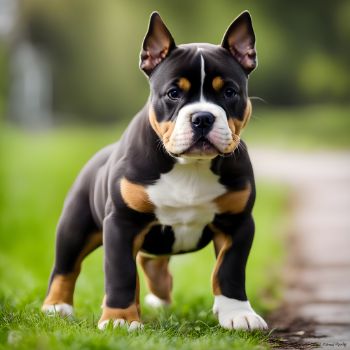
Fitness testing: Ethical breeders health test their breeding stock for common genetic diseases. It helps to ensure that their puppies are less likely to inherit these diseases.
Quality Care: Dogs should be raised in a clean and safe environment. Ethical breeders provide proper nutrition, exercise, and healthcare.
Selective Pairing: Responsible breeders carefully choose mating pairs to improve the breed. They consider factors like temperament, conformation, and genetics.
No Overbreeding: Ethical breeders avoid overbreeding their dogs, which can lead to illness. They limit the number of litters a dog can have.
Why Avoid Backyard Breeders for Tri-Color Bullies?
Backyard breeders are people who breed dogs without any regard for the well-being of the puppies.
Behavioral problems: Backyard breeders may need to socialize their puppies properly. This can lead to behavioral problems such as aggression, fearfulness, and anxiety.
No Support: Backyard breeders typically don’t offer support or guidance for new puppy owners.
Contributing to Overpopulation: Supporting backyard breeders can perpetuate overbreeding and the problem of homeless dogs.
Tri-Color Bully in Pop Culture:
Tri-Color Bullies have become increasingly popular in popular culture in recent years. They have been featured in a number of movies, TV shows, and social media posts.
Tri-Color Bullies have also been featured in several popular movies and TV shows.
For example, a Tri-Color Bully named Boss starred in the 2017 movie “The Fate of the Furious.”
Some notable Tri-Color Bully personalities and influencers include:
- Venom: A Tri-Color Bully owned by rapper Lil Pump. Venom has over 1.6 million followers on Instagram.
- Huk: A Tri-Color Bully owned by rapper and entrepreneur Pitbull. Huk has over 1.1 million followers on Instagram.
- Thor: A Tri-Color Bully owned by rapper and entrepreneur Rick Ross. Thor has over 700,000 followers on Instagram.
- Boss: A Tri-Color Bully owned by rapper and entrepreneur Fat Joe. Boss has over 400,000 followers on Instagram.
- Gucci: A Tri-Color Bully owned by rapper and entrepreneur Gucci Mane. Gucci has over 200,000 followers on Instagram.
Tri-Color Bullies have also appeared in TV shows such as “Animal Kingdom” and “Love & Hip Hop.”
Tri color bully colors:
Black Tri Bully:
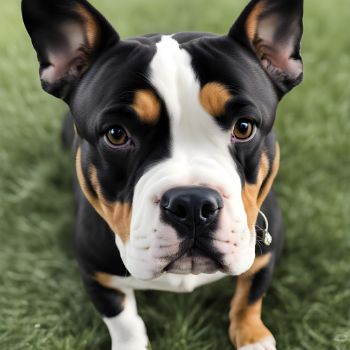
A Black Tri Bully is a Tri-Color Bully that primarily features black, white, and tan colors in its coat.
These dogs have a black base color with white markings on their chest, face, and paws.
They also have tan points, usually above their eyes, on their cheeks, and on their legs.
The Black Tri Bully is a recognized color variation within the American Bully breed standard.
This means that it’s an accepted and valued coat color in the breed.
Black Tri Merle Bully:
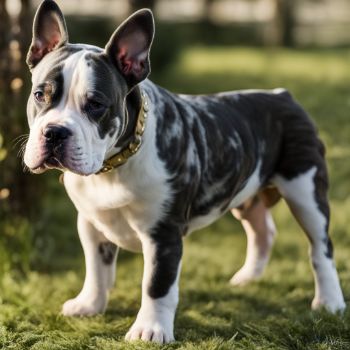
A Black Tri Merle Bully is a type of American Bully with a black coat with white, tan, and merle markings.
The merle pattern creates a speckled or mottled effect in their coat, with patches of darker and lighter shades.
These dogs have a combination of black, white, and tan colors in their fur, just like a traditional Black Tri Bully.
The Black Merle Bully is a recognized color variation in American Bullies. It is recognized by the American Bully Kennel Club (ABKC).
Black Tri Merle Bullies are relatively rare, but they are becoming increasingly popular.
They are known for their unique and beautiful coats.
Blue Tri Bully:
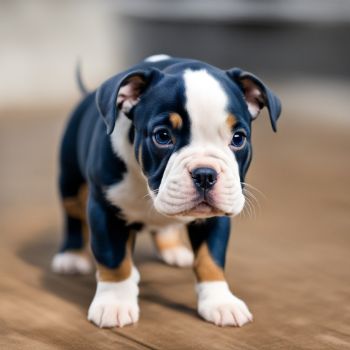
It features blue, white, and tan colors in its coat.
These dogs have a blue base coat color with white markings on their chest, face, and paws.
They also have tan points, typically above their eyes, on their cheeks, and on their legs.
Any major kennel clubs do not currently recognize the Blue Tri Bully.
However, there are many breed clubs that recognize the Blue Tri Bully, including the American Bully Kennel Club and the United Kennel Club.
Blue Fawn Tri Bully:

When we talk about a Blue Fawn Tri Bully, we’re referring to a Tri-Color Bully with a blue fawn base coat color, white markings on its chest, face, and paws, along with tan points.
These dogs have a blue fawn base coat, which is a lighter shade of blue with a fawn tint.
They also feature white markings on specific areas of their body and tan points, often seen above their eyes, on their cheeks, and on their legs.
The Blue Fawn Tri Bully is not currently recognized by any major kennel clubs.
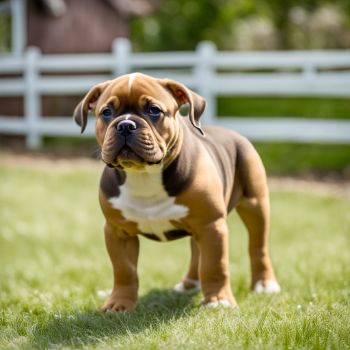
Fawn Tri Bully:
It is characterized by its fawn-colored base coat with black and white markings.
The black markings are typically found on the head, back, and tail, while the white markings are typically found on the chest, paws, and underbelly.
This dog has a coat with three distinct colors, which are usually black, white, and a tan or fawn color.
The Fawn Tri Bully is a relatively new color variation, and it has yet to be recognized by all major kennel clubs.
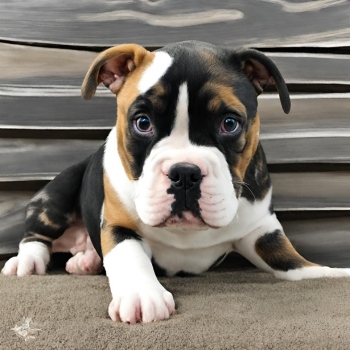
Ghost tri color Bully:
When people say “Ghost Tri Color Bully,” they are talking about a specific look of American Bully dogs with three distinct coat colors.
It has three coat colors, which can include shades like black, white, and grey.
These colors blend together on the dog’s fur.
The ghost tri bully is not yet a fully recognized breed by the American Kennel Club (AKC).
Champagne Ghost Tri Bully:
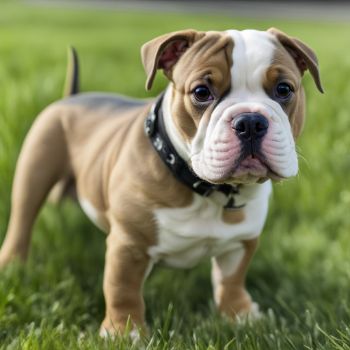
The term “champagne” refers to the dog’s coat’s light brown or fawn color, while the term “ghost” refers to the fact that the markings on the dog’s coat are often faint or muted.
It is not an officially recognized breed. Champagne Ghost Tri Bullies typically have a white base coat with champagne markings on their head, ears, and legs.
Some Champagne Bullies may also have brown or black markings.
The markings on a Champagne Ghost Bully’s coat can vary in size and intensity, and no two dogs are exactly alike.
Blue Ghost Tri Bully:
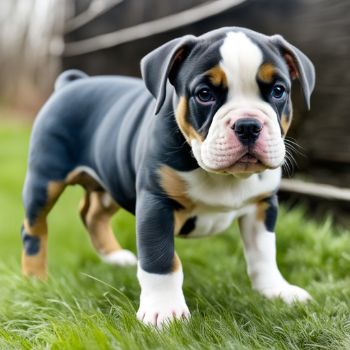
A Blue Ghost Tri Bully is an American Bully with a blue-grey coat and tan markings.
“Blue Ghost” refers to the prominent bluish tint in the dog’s coat.
It’s like a soft, ghostly blue hue that sets them apart from other tri-color bullies.
Blue Ghost Tri Bullies have a blue-grey base coat with tan markings on the face, chest, legs, and tail.
The tan markings may be light or dark, and they may be solid or brindled.
Blue Ghost Tri Bullies are recognized by the American Bully Kennel Club (ABKC).
While the Blue Ghost Tri Bully is not a separate breed, it’s highly appreciated and recognized for its exceptional color pattern.
Black Ghost Tri Bully:
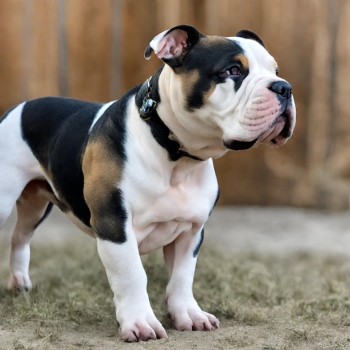
The Black Ghost Tri Bully has a black base coat with white and brindle markings.
The brindle markings can be light or dark and can be concentrated in certain areas of the body, such as the face, legs, or chest.
It is not a recognized breed by the AKC, but it is recognized by several other kennel clubs, such as the United Kennel Club (UKC) and ABKC.
Green Tri-Color American Bully:
A Green Tri Bully is a rare dog with a three-colored coat of white, black, and green.
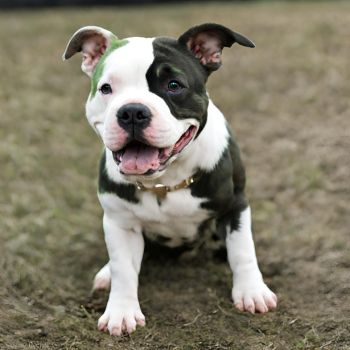
The green can range from a light grey to a deep emerald green.
Any major kennel clubs do not recognize this breed.
- Most common: White with black and green spots.
- Less common: Black with white and green spots.
- Very rare: Green with white and black spots.
The most common pattern is for white to be the primary color, with black and green spots.
The spots can be large or small, and they can be spread evenly over the body or concentrated in certain areas.
Tricolor Champagne Bully:
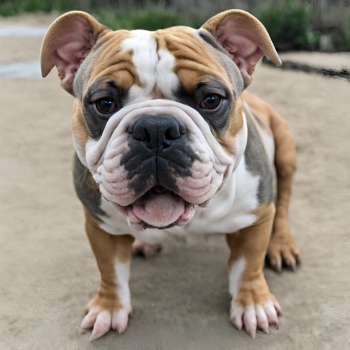
Champagne tri bully is characterized by its tri-colored coat of champagne, black, and white.
The champagne color is a light golden brown ranging in hue from pale to dark.
The black and white markings are typically distributed evenly on the body but can vary in pattern.
It is Recognized by the American Bully Kennel Club (ABKC).
You might see the champagne-like color on the body, white on the paws and chest, and some tan patches.
Champagne ghost tri bully is also called “chocolate ghost tri bully” or “Reverse Tri-Color Bully” due to the base color of its coat.
White Tri Bully:
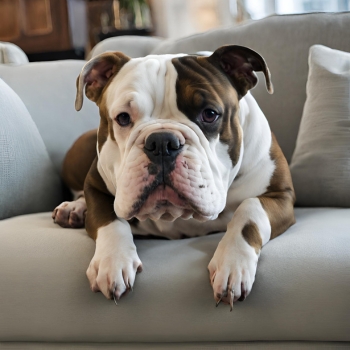
A White Tri-color Bully has a white base coat with tan and black markings.
The white is often the dominant color, covering most of the body.
Black and brown spots or patches can be found in smaller areas.
The brown markings are typically found on the face, chest, legs, and tail, while the black markings are on the back, head, and ears.
All major American Bully kennel clubs recognize the White Tri Bully color variation.
Sable Tri Bully:
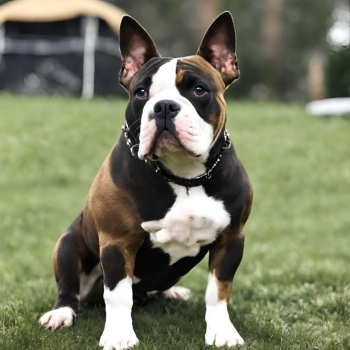
Sable Tri Bully is a dog with a sable coat base color and white and black patches.
The sable coat is a mix of black and brown hairs, with the black hairs being more concentrated at the tips.
The tri-color markings are white, tan, and sable.
The sable color forms the base and covers most of the body. Black and white patches are spread throughout, creating a tri-color pattern.
Typically, the head and face have prominent black-and-white markings.
The Sable Tri Bully is recognized by the American Bully Kennel Club (ABKC) and the United Kennel Club (UKC).
Red tri color Bully:
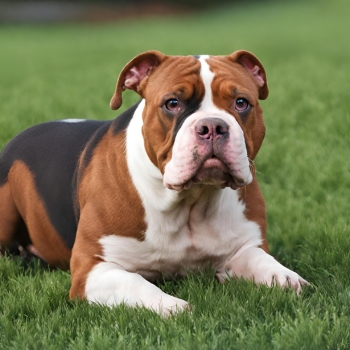
A red tricolor bully is an American Bully dog with a primarily red coat with black and white markings.
Red: This is the dominant color and covers most of the body, typically on the head, back, and sides.
Black: Black markings can be on the face, ears, and occasionally on the back.
White: White is usually on the chest, paws, and sometimes on the neck.
Red tricolor bullies are recognized by the American Bully Kennel Club (ABKC).
Piebald Tri Bully:
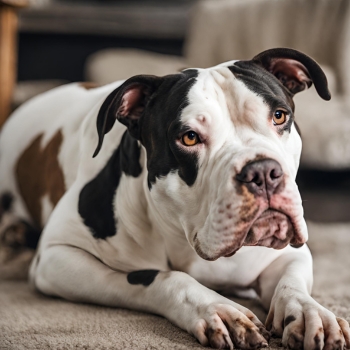
A Piebald Tri Bully is an American Bully dog with a coat of three colors, with white as the base color and patches of two other colors.
The distribution of the patches can vary widely, but they are typically located on the head, chest, legs, and tail.
The two other colors can be any of the following: black, red, blue, lilac, or chocolate.
The term “piebald” refers to a coat pattern having large areas of white and patches of other colors.
Major kennel clubs, including the AKC do not recognize the Piebald Tri Bully.
Ticked Tri Bully:
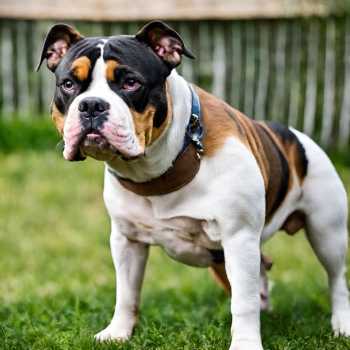
A Ticked Tri Bully is a type of American Bully with a three-colored coat that is also ticked.
Ticking is a pattern of small, light-colored spots on a darker base color.
Ticked Tri Bullies can have a variety of coat colors, including:
- Black tri with ticking
- Blue tri with ticking
- Chocolate tri with ticking
- Lilac tri with ticking
- Red tri with ticking
The ticking can be on any part of the body, but it is most commonly seen on the legs, chest, and belly. Ticked Tri Bullies are not recognized by any major kennel clubs.
Grey tri color Bully:
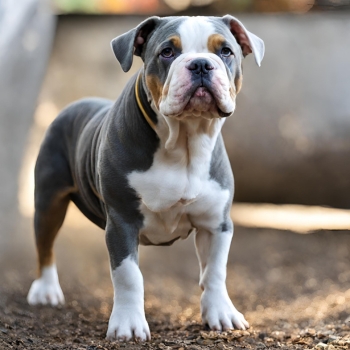
A grey tri-color bully has a coat of grey, white, and a third color, which is typically black, brown, or tan.
The grey color is usually the most dominant, covering most of the dog’s body.
It has black patches and white markings.
The American Bully is recognized by the ABKC and the United Kennel Club (UKC).
Tri Brindle Bully:
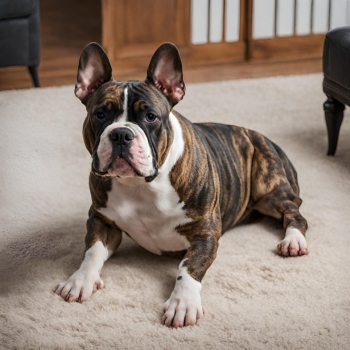
A Tricolor Brindle Bully has a base color, white, and tan creating stripes of different colors on the coat.
The brindle pattern creates streaks and swirls of these colors.
- Base color: The base color of a Tri Brindle Bully can be any color, but the most common are black, chocolate, blue, and lilac.
- White: Tri Brindle Bullies must have white markings on their chest, paws, and tails.
- Tan: Brindle tri Bully exhibits tan markings on its face, ears, and legs.
Other names:
- Triple Brindle Bully
- Tri-Brindle American Bully
- Brindle Tri-Color Bully
- Trindle color bully
Triple Brindle Bullies are recognized by all major American Bully registries, including the ABKC and the UKC.
Tri Merle Bully:
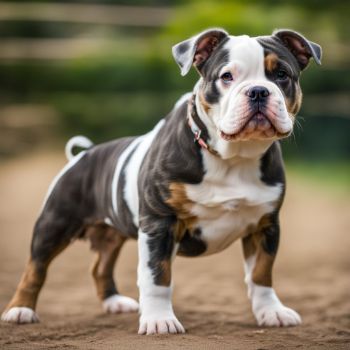
Merle Tri Bully is a coat color pattern in Bullies that combines the Merle gene with three solid base coat colors: black, brown, and white.
Tri Merle Bullies can have a wide range of coat colors, depending on the combination of Merle and base coat colors.
Some common colors include:
- Black Merle Tri
- Brown Merle Tri
- Chocolate Merle Tri, etc
The Merle gene causes patches of lighter color to appear on the base coat of the dog.
Tri Merle Bullies are recognized by all major American Bully registries.
Brown tri color Bully:
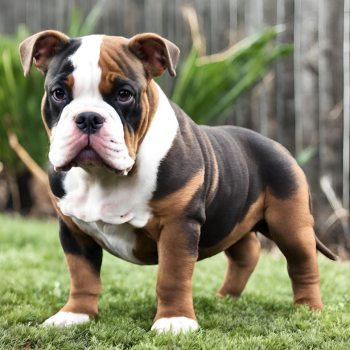
A brown tri-color bully is a specific type of dog with a three-color coat, including brown, black, and white.
This breed has a coat of three main colors: brown (a rich chocolatey hue), black (usually in the form of patches), and white.
The brown in a brown tri-color bully’s coat can range from light chocolate to dark mahogany. The white is usually found on the dog’s chest, paws, and tail. The third color is typically found on the dog’s head, back, and legs.
Some dogs may have a mostly brown coat with white markings, while others may have a mostly white coat with brown and third-color markings.
Purple Tri Bully:
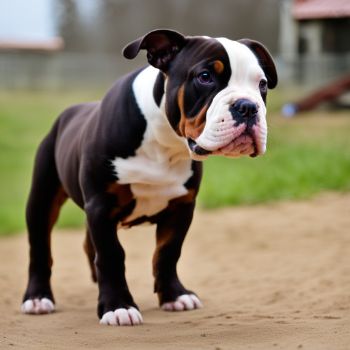
A purple tri color bully has a coat with a base color of black having small patches or spots of purple and white.
The purple color typically appears in small patches or spots on the dog’s coat, mixed with black and white.
These colors are spread out over the dog’s body harmoniously. The ABKC recognizes Purple Tri Bullies.
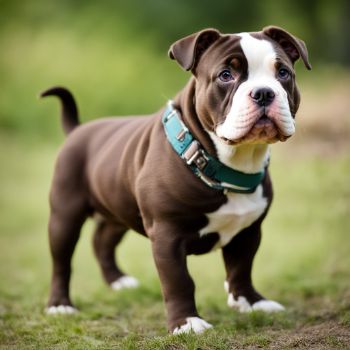
Chocolate Tri Bully:
Chocolate Tri color Bully is a dog with a coat that has three colors: chocolate, white, and black.
The chocolate brown usually covers their body, while the white appears on their chest and paws.
Black markings often accentuate their face. The ABKC and UKC recognize them.
Chocolate Tri Merle Bully:
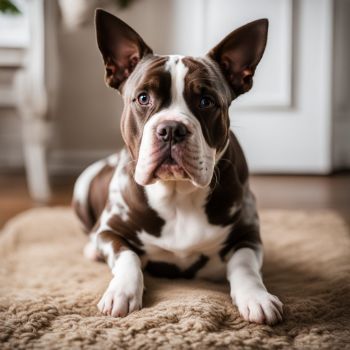
It combines chocolate brown and other colors, often with a merle pattern.
Merle means they have a mottled or speckled coat, usually with lighter and darker patches.
The distinctive colors and patterns are spread across their body, giving them a marbled or speckled appearance.
You’ll often see these striking colors on their coat, including fur, ears, and even eyes.
Buckskin Tri-Color Bully:
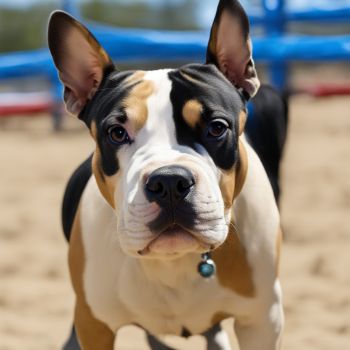
Buckskin is a soft, pale brown color that resembles the color of deer hide, hence the name “buckskin.”
Buckskin dogs typically have brown eyes and black noses.
These dogs have a coat that combines a light brown or tan color (resembling buckskin) with three primary colors, often including black, white, and brown.
The distinctive colors and patterns are spread across their body.
You’ll often see the buckskin base color with black, white, and brown patches.
These colors can be on their fur, ears, and sometimes their eyes. ABKC recognizes it.
Lilac tri-color Bully:
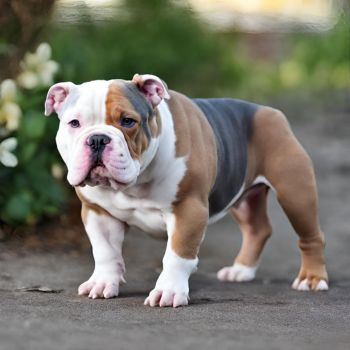
A lilac tri bully has a coat primarily of lilac (a light brownish-grey color) with two other colors, typically white and tan.
The lilac, white, and tan colors on a lilac tri-color bully are typically distributed evenly over the body, but there can be some variation.
For example, some bullies may have more white on their chest and stomach, while others may have more lilac on their back along with tan markings on their eyebrows, cheeks, and legs. UKC and ABKC acknowledge it.
What is the rarest color bully?
The rarest color bully is the lilac tri-color bully. Lilac is a light brownish-grey color that is caused by a dilution of the chocolate gene. Lilac tri-color bullies are rare because they must have two copies of the lilac gene, which is not very common.
What are the different colors of a bully?
American Bullies come in a variety of colors, including:
Black
Brown
Chocolate
Lilac
Merle
Brindle
White
Combinations of the above colors
Is haircut an important part of a tri-colored bully’s grooming?
Yes, haircuts are an important part of grooming for tri-colored bullies. Their coats can be prone to matting and tangling, so it is important to brush them regularly and trim their hair as needed.
How do you know if you have tri bully?
You can identify a tri-color bully by its coat displaying three distinct colors in specific areas. The three colors are typically distributed evenly over the body, but there can be some variation.
Final Words:
The Tri-Color Bully is a remarkable breed with its unique coat pattern of three distinct colors. Whether it’s the rarest Lilac Tri or any other combination, these dogs captivate with their striking appearances. Identifying them is easy – look for those three colors in the right places.
Taking care of their grooming, while not necessarily focused on haircuts, is crucial to keep them fit and clean. So, if you’re considering a pet, remember that Tri-Color Bullies are a fantastic choice. Their extraordinary looks and lovable personalities make them stand out in the world of dog breeds.

